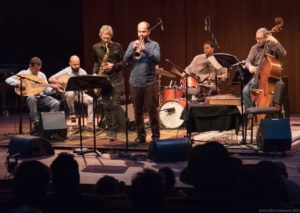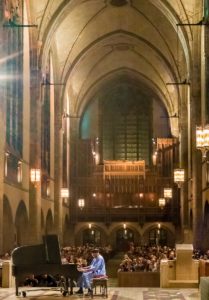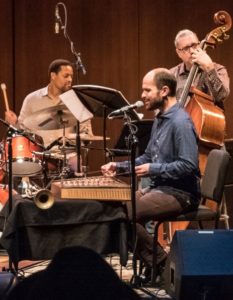Pianist Randy Weston, a magisterial musician at age 90 inspired by jazz traditions and its African basics, and trumpeter Amir ElSaffar, who has devoted himself to incorporating the Middle East’s modal, microtonal maqam legacy into compositions for jazz improvisation by members of his Two Rivers Ensemble, were highlights of last weekend’s 10th annual Hyde Park Jazz Festival. Both acts brought influences from afar back home.
The two-day fest in the neighborhood soon to host Barack Obama’s presidential library focused on local performers familiar to Chicago’s south side audiences — such as pianist Willie Pickens, alto saxist Greg Ward and singer Dee Alexander — performing on outdoor stages at the ends of a four-block long stretch of the Midway Plaisance (essentially, 59th St) girding the University of Chicago campus. I was busy at the nearby Logan Center the premiere of “Chicago’s Record Man: A Conversation with Bob Koester,”commissioned by the HPJF I co-directed with Matt Mehlan (who was out video-shooting other acts). There were also sets scattered around in venues as far off as the Little Black Pearl art and design center on 47th St., almost two miles away, the DuSable Museum (where trumpeter Orbert Davis’ Sextet had listeners to overflowing for a tribute to the late Freddie Hubbard), and other University facilities.
At 11 pm on a blissfully temperate fall Saturday night, Rockefeller Chapel, a studiously non-denominational example of “Collegiate Gothic” architecture with a 200 foot high tower, matched the grandeur of Weston’s rumbling bass motifs and sparkling right hand melodic variations. Although the vast hall’s acoustics tend to minimize if not blur piano notes, Weston knew how to play it: sparely, with selective emphasis, taking time to let pitches ring and fade. His music flows like a slow but steady river, and staples of his repertoire including “Blue Moses,” “Little Niles,” “Berkshire Blues” and “African Sunrise” (commissioned in 1984 by the Chicago Jazz Festival for Weston to perform with an orchestra including Dizzy Gillespie) seemed ageless, ancient and enduring.

Two Rivers Ensemble, from left: Tareq Abboushi, Zafer Tawil, Ole Mathisen, Amir ElSaffar, Nasheet Waits, Carlo DeRosa; photo by Marc PoKempner
Several hours earlier a few hundred people came in from the sunny afternoon to the Logan Center performance hall to hear ElSaffar and his Two River Ensemble. A Chicago native who grew up seriously studying Western European classical and American vernacular music, ElSaffar, now 39, began researching his Iraqi ethnic heritage in 2002, spending two years abroad to learn maqam vocal techniques and santur (hammered dulcimer) that are now central to his compositions and concept.
What he’s accomplished is remarkable. He’s affected a genuine absorption and adoption by his sextet members of Arab practices about harmony, ornamentation, intonation and rhythmic cycles in high contrast to American music’s familiar conventions. Simultaneously he’s managed to open those Middle Eastern elements to the expressive freedoms of spontaneous and often urgent improvisation.
In practice what this meant was ElSaffar and tenor saxophonist Ole Mathisen played tight, repetitive, minorish riffs in near-unison over the synchronized string and sometimes hand drum parts of Zafer Tawil and Tareq Abboushi, while Nasheet Waits drove the entire band from his traps, modulating volume nicely, and Carlo DeRosa supplied virtuosic bass lines.
On occasion ElSaffar sat at his santur, striking ping-like tones. At their concert climax Mathisen was wailing with all the fiercely garrulous grit of an Old Testament prophet, while ElSaffar flailed with delicate strikers at the wire of his small, trapezoidal instrument. It was difficult to hear the hammered dulcimer’s sound — ElSaffar said he couldn’t hear it onstage — but the entire band’s fervor, grounded and moving on interlocking rhythms, was palatable. The Two Rivers Ensemble offered unusually new music and the seasoned Hyde Park Jazz Festival audience, ready for something more that simply pleasant background swing, stayed with the adventure, by the end gratified with risks and rewards, just as jazz intends.
Â
howardmandel.com
Subscribe by Email |
Subscribe by RSS |
Follow on Twitter
All JBJ posts |


